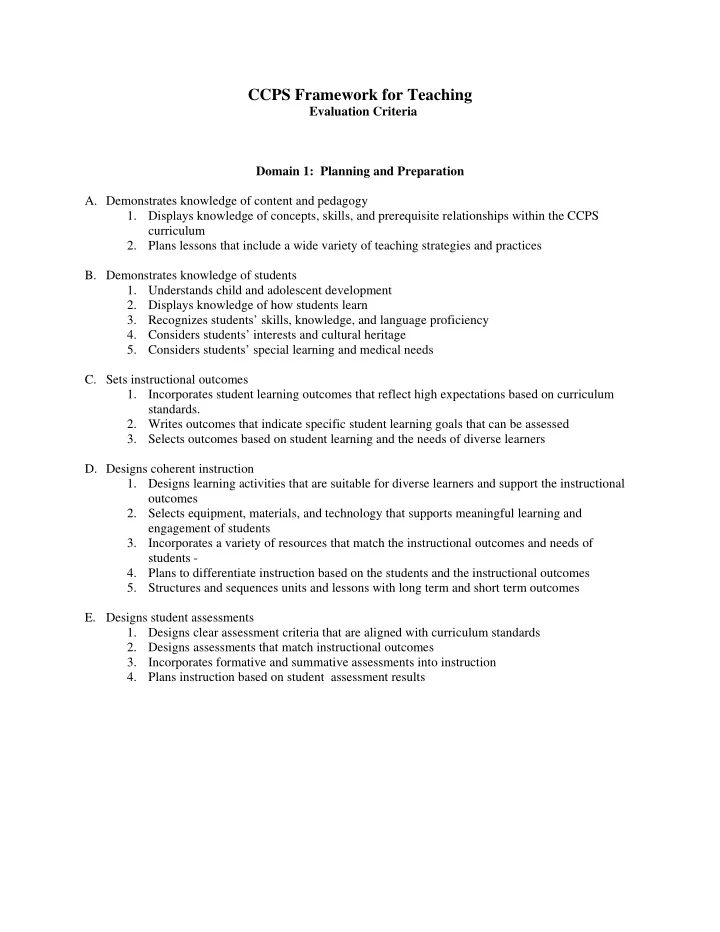

CCPS Framework for Teaching Evaluation Criteria Domain 1: Planning and Preparation A. Demonstrates knowledge of content and pedagogy 1. Displays knowledge of concepts, skills, and prerequisite relationships within the CCPS curriculum 2. Plans lessons that include a wide variety of teaching strategies and practices B. Demonstrates knowledge of students 1. Understands child and adolescent development 2. Displays knowledge of how students learn 3. Recognizes students’ skills, knowledge, and language proficiency 4. Considers students’ interests and cultural heritage 5. Considers students’ special learning and medical needs C. Sets instructional outcomes 1. Incorporates student learning outcomes that reflect high expectations based on curriculum standards. 2. Writes outcomes that indicate specific student learning goals that can be assessed 3. Selects outcomes based on student learning and the needs of diverse learners D. Designs coherent instruction 1. Designs learning activities that are suitable for diverse learners and support the instructional outcomes 2. Selects equipment, materials, and technology that supports meaningful learning and engagement of students 3. Incorporates a variety of resources that match the instructional outcomes and needs of students 4. Plans to differentiate instruction based on the students and the instructional outcomes 5. Structures and sequences units and lessons with long term and short term outcomes E. Designs student assessments 1. Designs clear assessment criteria that are aligned with curriculum standards 2. Designs assessments that match instructional outcomes 3. Incorporates formative and summative assessments into instruction 4. Plans instruction based on student assessment results
Domain 2: The Classroom Environment A. Creates an environment of respect and rapport regardless of cultural or developmental differences 1. Demonstrates caring and respect for all students 2. Promotes an atmosphere in which students are willing to take risks 3. Encourages polite and respectful student interaction B. Establishes a culture for learning 1. Sets high expectations for learning and achievement for all students 2. Communicates and demonstrates the importance of the content 3. Encourages student pride in work C. Manages classroom procedures 1. Manages instructional groups to maximize student engagement 2. Provides smooth transitions to minimize loss of instructional time 3. Establishes classroom rules and routines and the handling of materials to maximize learning time 4. Establishes systems for performing non-instructional duties 5. Establishes roles and routines for volunteers and paraprofessionals, as appropriate D. Manages Student Behavior 1. Establishes expectations for appropriate student behavior 2. Monitors student behavior and intervenes when necessary 3. Responds to misbehavior consistently and appropriately with sensitivity to the student’s dignity E. Organizes Physical Space 1. Organizes the classroom to ensure the safety of all students 2. Organizes available classroom space so that all students have access to learning Domain 3: Instruction A. Communicates with students 1. Communicates expectations for learning 2. Provides sequential directions and procedures 3. Provides relevant explanations of content 4. Uses appropriate oral and written language B. Uses questioning and discussion techniques to promote higher level thinking 1. Poses quality questions that promote higher level thinking 2. Uses discussion techniques to engage students 3. Encourages student participation C. Engages students in meaningful learning 1. Provides activities and assignments to promote active learning 2. Groups students purposefully 3. Uses instructional materials, technology, and resources to enhance student learning 4. Paces and structures the lesson to maximize instruction and learning
D. Uses assessment in instruction 1. Establishes and communicates criteria for learning and assessment 2. Monitors student learning and progress through formative and summative assessment 3. Provides purposeful feedback to students 4. Provides students with opportunities to self-assess and monitor progress E. Demonstrates flexibility and responsiveness 1. Modifies the planned lesson when appropriate 2. Persists in seeking alternatives for students who have difficulty mastering the learning outcomes 3. Connects learning to student interest Domain 4: Professional Responsibilities A. Reflects on teaching and lesson effectiveness 1. Assesses lesson effectiveness based on student learning 2. Identifies specific alternative instructional options for future teaching B. Maintains accurate records 1. Maintains records of student progress, assignment completion, and achievement aligned to the CCPS grading policy 2. Maintains non-instructional records (such as attendance, subplans, etc.) C. Communicates with families 1. Provides information about the instructional program 2. Provides information about individual student progress on a regular basis 3. Makes an effort to engage families D. Participates in a professional community 1. Maintains professional relationships with colleagues and collaborates with others 2. Contributes to the achievement of school improvement goals and system-wide initiatives 3. Participates in a culture of professional learning E. Grows and develops professionally 1. Provides evidence of professional growth 2. Acknowledges feedback from supervisors and colleagues F. Shows professionalism 1. Displays integrity and ethical conduct 2. Advocates for all students 3. Exhibits a professional attitude and positive demeanor 4. Complies with CCPS and school regulations Adapted with permission from Danielson, Charlotte . Enhancing Professional Practice: A Framework For Teaching. 2 nd ed . Virginia: ASCD, 2007 Rev. 6.16.11
Recommend
More recommend